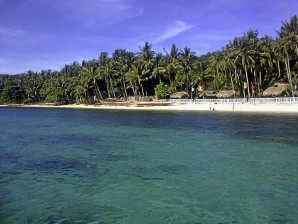Northern Samar offers undisturbed paradise islets

A CENTURY-OLD lighthouse in the island-town of Capul is used to warn ships as they enter the narrow and treacherous waters of San Bernardino Strait. VICENTE S. LABRO
TACLOBAN CITY, Leyte—Northern Samar will soon be found on the tourism map.
The provincial government is developing four beautiful, undisturbed islands as premier tourist destinations—Biri, Capul, San Antonio and San Vicente, all along the San Bernardino Strait separating Samar and Luzon.
Its top priority will be Biri, which is famous for its awe-inspiring rock formations that have been carved by weathering, or the gradual crashing of the sea on the rocks.
“Biri is really the icon destination,” said Josette G. Doctor, provincial tourism officer. The place, including its natural seawater pools, has been a favorite among picnickers and photography enthusiasts, especially during summer when the weather is good.
“We also have good diving sites, potential surfing areas and white-sand beaches,” Doctor said. Coral reefs are now being mapped, and buoys or markers are being floated to identify the snorkeling and diving sites.
A circumferential road is being built to make the whole island-town accessible, especially to the diving and surfing areas.
Familiarization tour
Members of the Philippine Tour Operators Association (Philtoa) recently went to Biri on a familiarization tour and found the visit to be “really a very, very nice experience for everybody.”
Cesar Cruz, president of the Philtoa, described as a “rarity in the Philippines” the white-sand beach and diving area “just two meters from the community.”

THE ISLAND-municipality of Biri is famous for its rock formations. Photo courtesy of Department of Tourism in Eastern Visayas
Biri has eight barangays with a land area of 24.5 square kilometers. It can be reached in 45 minutes by motorboat from Lavezares town in the mainland.
Lavezares is 45 minutes by land travel from the capital town of Catarman, where flights to Manila are available.
Capul boasts of a 16th-century church and a century-old lighthouse. The church was not only a place of worship but also a refuge from Moro raids in the early days. Recently, it was declared a historical site by the National Historical Commission.
Ancient lighthouse
The lighthouse, which is 143 feet above sea level, warns ships that they are entering the narrow treacherous waters of the San Bernardino Strait. Its tower and pavilion were built by the Spaniards in 1896. These were completed only by US military engineers in the early 1900s.
During the Spanish time, Capul also became the last stop on Philippine soil of the departing galleons before the long trip to Acapulco in Mexico. Travelers often got their provisions in the island.
On a clear day, one can see Mt. Bulusan in Sorsogon and some islets in Masbate from the lighthouse.
Doctor says the dilapidated pavilion would be repaired, the mini park improved, and a building to accommodate tourists put up near the facility.
What is really unique about Capul is the local dialect called Inabaknon, which is similar to that of the Badjaos in the South, she says. People in the neighboring islands of San Antonio and San Vicente speak Cebuano while those in Biri speak Waray.

TOURISTS are expected to enjoy the stretch of white-sand beach on the island-municipality of San Antonio. VICENTE S. LABRO
Capul residents have also preserved some old dances and songs. Doctor says the island was called Abak in honor of King Abak, who ruled the first settlers.
Capul also boasts of beautiful white beaches, snorkeling areas and diving sites. Composed of eight barangays, it is a fifth class municipality (annual income: P15 million-P25 million) and has a total land area of 35 sq km. It can be reached in 45 minutes by boat from Allen town, which is 48 km from the capital town of Catarman where flights to Manila are available.
San Antonio and San Vicente have great beaches, Doctor says. Five resorts are now operating in San Antonio, actually Dalupiri Island, which is ideal for scuba diving, snorkeling and fishing.
San Antonio, a Cebuano-speaking sixth class municipality (annual income: below P15 million), has a land area of 27 sq km and 10 barangays. It can be reached in 30 minutes by boat from Victoria town.
San Vicente, which is near Masbate Island, has six other islets with beautiful beaches. One of the islets has “pinkish” sand, Doctor says.
The island can be reached in two hours by boat from San Isidro town.
Doctor says the province will be offering island-hopping tours to the four paradise islands.














